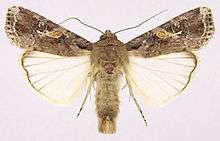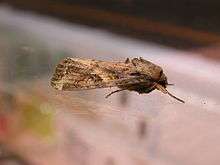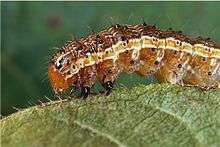Fall armyworm
| Fall armyworm | |
|---|---|
 | |
 | |
| Scientific classification | |
| Kingdom: | Animalia |
| Phylum: | Arthropoda |
| Class: | Insecta |
| Order: | Lepidoptera |
| Family: | Noctuidae |
| Genus: | Spodoptera |
| Species: | S. frugiperda |
| Binomial name | |
| Spodoptera frugiperda (J.E. Smith, 1797) | |
The fall armyworm (Spodoptera frugiperda) is a species in the order of Lepidoptera and is the larval life stage of a fall armyworm moth. The term "armyworm" can refer to several species, often describing the large-scale invasive behavior of the species' larval stage. It is regarded as a pest and can damage and destroy a wide variety of crops, which causes large economic damage. Its scientific name derives from frugiperda, which is Latin for lost fruit, named because of the species' ability to destroy crops.[1] Because of its propensity for destruction, the fall armyworm's habits and possibilities for crop protection have been studied in depth. It is also a notable case for studying sympatric speciation, as it appears to be diverging into two species currently.[2] Another remarkable trait of the larva is that they practice cannibalism.
The fall armyworm is active at a different time of year than the true armyworm, another species in the order Lepidoptera and family Noctuidae, but of the genus Mythimna. Outbreaks of the true armyworm usually occur during the early part of the summer; the fall armyworm does most damage in the late summer in the southern part of the United States, and early fall in the northern regions.[3]
Description
The adult moths are 32 to 40 mm wing tip to wing tip, with a brown or gray forewing, and a white hind wing. There is slight sexual dimorphism, with males having more patterns and a distinct white spot on each of their forewings. The first larval instar is light colored with a larger dark head. As they develop through instars, they become browner with white lengthwise lines. They also develop dark spots with spines.[4]
Geographic range

The fall armyworm is widely distributed in Eastern and Central North America and in South America. Since 2016 it is invasive in Africa. It cannot overwinter in below freezing temperatures,[5][6] so it only survives the winter in the most Southern regions of the United States, namely Texas and Florida. Because of this, the fall armyworm is a more prominent pest in southeastern states. However, seasonally it will spread across the Eastern United States and up to Southern Canada, inhabiting areas with suitable food supplies.[4] It was first reported in Africa, in 2016 where it is causing significant damage to maize crops and has great potential for further spread and economic damage.[7] It has since spread to 28 countries in Africa [8] In 2018 it began being widespread in India.[9]
Food resources
Caterpillars
.jpg)
The armyworm's diet consists mainly of grasses and small-grain crops such as corn, but the species has been noted to consume over 80 different plants.[10] Armyworms earned their common name by eating all plant matter they encounter in their wide dispersals, like a large army. A few sweet corn varieties have partial, but not complete, resistance to armyworms.[4] The resistance comes from a unique 33-kD proteinase that the corn produces when it is being fed on by fall armyworms or other larva. This protein was found to significantly decrease fall armyworm larva growth.[11]
Cannibalism
When possible, larva will cannibalize the larva of smaller instars. A 1999 study showed that cannibalism only benefits the caterpillar when other food is scarce. Despite this, the caterpillars will cannibalize others whenever they can, even though it was found to decrease their own fitness in many cases. One known reason why cannibalism is detrimental to the fall armyworm is because of disease transmission to the cannibal. In nature, the negative effects of cannibalism may be balanced by the fact that cannibalism removes competitors, thereby making more resources accessible and indirectly increasing fall armyworms' fitness.[12]
Adults
Adult moths sip nectar from flowers such as that of witch hazel (Hamamelis virginiana).[13]
Life history
The fall armyworm's life cycle is completed within 30 days during summer, and 60 days during the spring and autumn seasons; during the winter, these caterpillars' life cycle lasts about 80 to 90 days.[3] The number of generations a moth will have in a year varies based on climate, but in her life span a female will typically lay about 1,500 eggs.[4] Because larva cannot enter into diapause they cannot survive cold temperatures.[13]
Egg
The armyworm's egg is dome shaped, and measures around 0.4 mm in diameter and 0.3 mm in height.[4] Females prefer to lay eggs on the underside of leaves, but in high populations they will lay them just about anywhere.[14] In warm weather, the eggs will hatch into larvae within a few days.
Larva
The larva go through six different instars, each varying slightly in physical appearance and pattern. The larva process lasts from 14 to 30 days, again depending on temperatures.[4] The mature caterpillar is about 1.5–2.0 inches (38–51 mm) in length.[1] This is the most destructive life stage as the larvae have biting mouth parts. The larvae have a distinctive inverted Y suture on the forehead.
Pupa
The larva then pupate underground for 7 to 37 days in a cocoon they form of soil and silk. Duration and survival of the pupal stage depend on the temperature of the environment.[14]
Adults
Once emerged, the adults live for about 10 days, and sometimes up to 21 days, with the female laying most of her eggs early in life.[4] Adults are nocturnal and fare best during warm and humid nights.[4]
Migration
Adults are capable of flying long distances, so even though they are unable to overwinter north of the southern region of the United States, the moths can migrate as far north as Southern Canada in warm months.[14][4] Their migration rate is remarkably fast, estimated at 300 miles per generation.[14] Some scientists speculate that this fast migration is aided by the movement of air in weather fronts.[14]
Enemies
Predators
Fall armyworm caterpillars are directly preyed on by many invertebrates and vertebrates. Common predators include birds, rodents, beetles, earwigs, and other insects. It has been shown that direct predation can cause significant losses to caterpillar populations.[4] The larva’s main defense against enemies is their ability to reach large numbers and migrate before seasonal conditions are suitable for predators.[14]
Parasitoids
Fly and wasp parasitoids target the fall armyworm, most commonly Archytas marmoratus, Cotesia marginiventris, and Chelonus texanus. The armyworm is also vulnerable to additional parasitoids, varying with location.[4]
Parasites and disease
Fifty-three different parasite species have been discovered in fall armyworm larva, spanning ten different families.[10] Often larva can survive through much of their crop consumption despite outbreaks of disease, because of the larva’s fast life cycle.[4] Despite this, parasites of the fall armyworm are being studied extensively as a means of fighting armyworm attacks on crops. One suggested approach would be to introduce parasites from South America to North American fall armyworms, and vice versa.[10]
Subspecies
The fall armyworm may be presently undergoing a divergence into two separate species. These two strains have major genetic differences that are connected to the plants they feed on, even though both still exist in the same area (sympatric speciation). These two strains can be loosely categorized into a rice strain and a corn strain. This separation is occurring because of differences in habitat (preferred host plant), and differences in reproductive behavior. The reproductive differences can be divided into two causes: difference in the timing of mating at night, and difference in female sex pheromones.[2]
Mating
Mate searching behavior and male-male conflict
A female attracts males by perching atop the host plant feeding area and releasing a sex pheromone as the signal that she wishes to mate. The pheromone has been studied and found to contain the components Z7-12 and Z9-14.[15] Each female only mates once per night; this creates a physical conflict between the multiple males that will fly towards a ready female. There is an order to which the females call and mate: virgin females do first, females who have mated once next, and females who have already mated multiple times call and mate last during the night.[14]
Interactions with humans
Pest of crop plants
Because of their food preferences, fall armyworm larvae can wreak havoc on a wide range of crops. The first historical account of the fall armyworm’s destruction was in 1797 in Georgia. Destruction can happen almost over night, because the first stages of a caterpillar's life require very little food, and the later stages require about 50 times more. Because of this rapid change in food consumption, the presence of larva will not be noticed until they have destroyed almost everything in as little as a night.[14] Some examples of targeted crops include cotton, tobacco, sweet corn, rice, peanuts, and even fruits such as apples, oranges, and many more. The list of possible food sources for the worms is extensive, so crop damage is wide-ranging.[4] It is estimated that almost 40% of those species that armyworms target are economically important.[10] Because the larva eat so much of the plant, they are very detrimental to crop survival and yield. In corn, larvae will even burrow into the corn ear to eat the kernels.[4]
Invasive presence in Africa
The fall army worm was identified in Africa in 2016. In early 2017, armyworms infested large swathes of corn crops across Southern Africa, devastating the livelihood of many farmers. It is thought they arrived as an invasive species from the Americas as eggs in imported produce.[16] This is causing immense concern among agricultural experts, due to the potentially huge amount of damage this invasive species will do to African food crops if allowed to spread.[17] Many African countries have agreed to take urgent actions against armyworms.[18]
Responses
Because of the fall armyworms' great destruction tendencies, farmers must go to great lengths to deter the larvae. Insecticide is a widely used form of protection; in Southern regions, farmers may have to apply insecticide to corn every day. Another strategy is to plant crops earlier to avoid the increase in armyworm numbers as the summer progresses.[4] In South Africa, farmers are using pheromone lures with a combination of Dichlorvos blocks to trap and eliminate male arymworms with the intention of disrupting mating cycles.[19]
Research use
S. frugiperda cells (Sf9 and Sf21 cell lines) are commonly used in biomedical research for the purpose of recombinant protein expression using insect-specific viruses called baculoviruses.
See also
- African armyworm (Spodoptera exempta) (Africa)
- Common armyworm or true armyworm (Mythimna unipuncta) (North and South America)
- Northern armyworm, Oriental armyworm or Rice ear-cutting caterpillar (Mythimna separata) (Asia)
References
- 1 2 "Species Spodoptera frugiperda – Fall Armyworm Moth – Hodges#9666". Retrieved 25 May 2017.
- 1 2 Groot, Astrid T.; Marr, Melanie; Heckel, David G.; Schöfl, Gerhard (2010-01-01). "The roles and interactions of reproductive isolation mechanisms in fall armyworm (Lepidoptera: Noctuidae) host strains". Ecological Entomology. 35: 105–118. doi:10.1111/j.1365-2311.2009.01138.x. ISSN 1365-2311.
- ↑ Luginbill, Philip (February 1928). "The Fall Army Worm". Technical bulletin (U.S. Dept. of Agriculture. Bureau of Entomology) (34).
- 1 2 3 4 5 6 7 8 9 10 11 12 13 14 15 "fall armyworm, Spodoptera frugiperda (J.E. Smith)". entnemdept.ufl.edu. Retrieved 2017-10-01.
- ↑ Murúa MG et al. (2009) Natural distribution of parasitoids of larvae of the fall armyworm, Spodoptera frugiperda, in Argentina Journal of Insect Science 9(20)
- ↑ Meagher RL and Nagoshi RN (2004) Population dynamics and occurrence of Spodoptera frugiperda host strains in southern Florida Ecological Entomology 29(5): s 614–620
- ↑ https://www.cabi.org/isc/datasheet/29810
- ↑ https://plantvillage.org/diseases/1329
- ↑ Hodal, Kate (2018-08-07). "Race to contain destructive march of armyworm as pest spreads to India". the Guardian. Retrieved 2018-08-07.
- 1 2 3 4 Ashley, T. R. (1979). "Classification and Distribution of Fall Armyworm Parasites". The Florida Entomologist. 62 (2): 114–123. doi:10.2307/3494087. JSTOR 3494087.
- ↑ Pechan, Tibor; Ye, Lijun; Chang, Yu-min; Mitra, Anurina; Lin, Lei; Davis, Frank M.; Williams, W. Paul; Luthe, Dawn S. (2000-07-01). "A Unique 33-kD Cysteine Proteinase Accumulates in Response to Larval Feeding in Maize Genotypes Resistant to Fall Armyworm and Other Lepidoptera". The Plant Cell Online. 12 (7): 1031–1040. doi:10.1105/tpc.12.7.1031. ISSN 1040-4651. PMC 149047. PMID 10899972.
- ↑ Chapman, J. W. (1999-05-01). "Fitness consequences of cannibalism in the fall armyworm, Spodoptera frugiperda". Behavioral Ecology. 10 (3): 298–303. doi:10.1093/beheco/10.3.298. ISSN 1045-2249.
- 1 2 "Fall Armyworm – Spodoptera frugiperda – Details – Encyclopedia of Life". Encyclopedia of Life. Retrieved 2017-11-29.
- 1 2 3 4 5 6 7 8 Sparks, Alton N. (1979). "A Review of the Biology of the Fall Armyworm". The Florida Entomologist. 62 (2): 82–87. doi:10.2307/3494083. JSTOR 3494083.
- ↑ Tumlinson, J. H.; Mitchell, E. R.; Teal, P. E. A.; Heath, R. R.; Mengelkoch, L. J. (1986-09-01). "Sex pheromone of fall armyworm,Spodoptera frugiperda (J.E. Smith)". Journal of Chemical Ecology. 12 (9): 1909–1926. doi:10.1007/BF01041855. ISSN 0098-0331.
- ↑ "Fall armyworm 'threatens African farmers' livelihoods' – BBC News". Bbc.com. Retrieved 2017-06-17.
- ↑ Briggs, Helen (2017-02-06). "Alien armyworm threatens African crops". BBC News. Retrieved 2017-11-15.
- ↑ FAO Regional Office for Africa. "Southern and Eastern African countries agree on urgent actions to tackle armyworm and other crop pests and animal diseases". fao.org. United Nations FAO. Retrieved 22 February 2017.
- ↑ "F.A.W. PheroLure ® - Insect Science". Insect Science. Retrieved 2018-04-15.
External links
- fall armyworm on the UF / IFAS Featured Creatures Web site
| Wikimedia Commons has media related to Spodoptera frugiperda. |